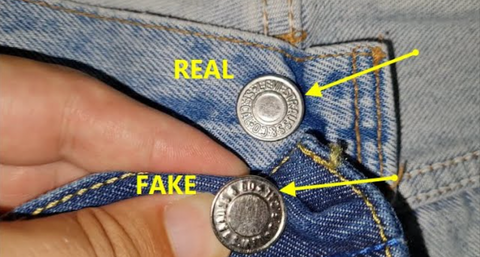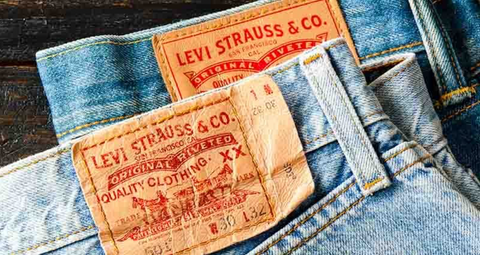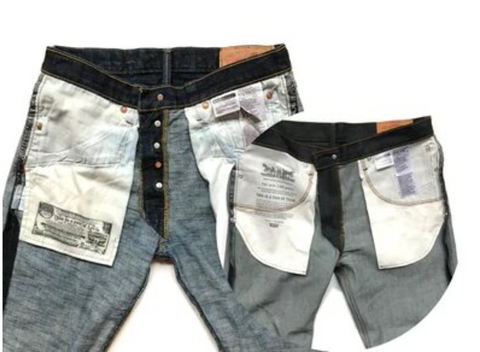In 1852, Levi Strauss, a German immigrant, opened a dry goods company in San Francisco through the peak of the California Gold Rush era. Throughout this time, he began to notice a need for durable and resistant clothing for the working people. With this in mind, he hired Jacob Davis, a tailor, who was able to reinforce strong denim with copper rivets, which saw the creation of the iconic “blue jeans” in 1873.
“YOU WEAR JEANS. YOU LIVE IN LEVI'S®.”
Most known for their authentic trademark denim, Levi’s is now one of the largest brand name apparel companies and an iconic global leader in both men’s and women's jeanwear. Today Levi Strauss & Co operate in over 100 countries, with more than 500 retail stores worldwide. Their 501 style has become a firm favourite of many denim lovers. Denim expert and trend forecaster Samuel Trotman stated “It is the ultimate original jean. I guess if you close your eyes and imagine Levi’s, most people will probably think of the 501, I think from an industrial point of view, that it's the most user-tested piece of human clothing ever worn.”
Unfortunately due to their successes as a brand, this welcomes the likes of counterfeit items creeping their way into circulation, essentially “ripping off” the notion of Levi’s authenticity as a brand and high quality product lines. However with the increased prevalence of counterfeit goods in the fashion retail today, how can you spot a fake pair of Levi’s?
Details to look out for in products
In order to ensure your Levi’s aren’t counterfeit, there are some distinct signs to be aware of. An obvious sign is the quality of the denim, however with the increasing improvement in similarity between the real deal and fakes, you may need to call on the help of a professional authentication service.
The brand patch or label
The iconic “two horses”, leather brand patch should appear on the waistband above the right hand back pocket. When identifying a fake, be sure to check the size is no smaller than the standard Levi’s patch, and that the shape is not abstract. Additionally one of the biggest telltale signs of counterfeit products in general is the printing technique used and lack of punctuation and grammar. According to American reserve clothing Co, “you should always look out for the style number, waist, and length. They’re always marked and are always a different colour than the rest of the label as those details are added after the labels are manufactured. ”As well as this, “SAN FRANCISCO CAL. '' should always appear on the second line.
The logo tab
The red logo tab is another classic detail utilised by Levi’s. Therefore it is extremely important to note that this tab should always appear 1-1¼” below the very top of the left hand side stitching of the right hand back pocket. This detail is added during the production process, therefore any varying stitching is a huge sign of a knockoff. Once again grammar is often wrong on fake logo tabs, be sure to check there is an ‘S’ on the end of Levi’s. Also any logo tabs with capital 'E" would date to pre 1971 production, therefore if they don’t look age appropriate, they are more than likely fake.

The metal hardware
Metal rivets across all pairs of Levi’s jeans should contain the letters “LS&CO-SF” stamped distinctly and should have 6 on the front of the jeans, importantly there should be none on the back! The waist button should be centred (as should the zipper) and clearly branded.

Inside the jeans
When taking a look inside your jeans, you should be sure that the run number on the back of the waist button and the run number on the fabric care tags match up, this small attention to detail is what sets aside the authentic products from the fakes! For modern Levi's, there will always be a certificate of authenticity stamped on the left hand pocket when you turn the jeans inside out.
Red flags to look out for when interacting with a seller
Finding trustworthy sellers can be hard when shopping secondhand or vintage fashion, especially when shopping online. However there are some guidelines you can abide by to reduce your risk of being scammed by those selling fakes.
Refusing to display a range of up close images
If a seller is legitimate, they are more than likely willing to show a range of different photos of their products, displaying close attention to detail. Therefore you should not feel uncomfortable asking to see close ups of the rivets, waist button, stitching, right back pocket tab or any other features you wish.
Bad or no rates as a seller
Trusted sellers tend to have loyal customer bases, therefore it could be a cause for concern if the seller has no ratings, or especially bad ones! However it is also important to be reminded that scammers can use fake ratings in order to create a false sense of legitimacy.
The seller has sold counterfeit goods previously
Similarly, If you can see a seller had been reported for selling counterfeit goods previously, whether they were Levi’s jeans or not, they are more than likely to pull off this scam again with a different product.
Where are the fakes being sold?
Today more than ever, people are turning to e-commerce platforms to fulfil their shopping wants and needs. Although this is great for convenience, it also makes it a lot harder to guarantee you are buying genuine designer label pieces, rather than low quality counterfeit goods. The rise of the circular economy has seen an increasing shift towards the use of peer-to-peer clothing retail sites such as Ebay, Depop and Vinted, meaning that essentially, anyone can sell to anyone. Despite this movement's positive aspirations of fuelling sustainable fashion, it has also caused controversy in regards to the growing presence of counterfeit products. Fake products are widely available across all these platforms, regardless of each of their efforts to regulate authentication.
Additionally, with the growth of the vintage clothing market catapulting over the last few years, independent vintage/thrift stores are becoming more and more common along the high street. Therefore if they are not sourcing products responsibly, they may find themselves also selling fakes. This means that the tips stated above are vital if you are browsing around for a pair of vintage Levi’s jeans.

The impact of counterfeit goods
Counterfeit goods are undeniably damaging to designer brands highly esteemed reputations. This is because consumers who may have unintentionally spent their hard earned cash on fake pieces, will blame the real manufacturers for falling short of their expectations. In Levi’s case this is likely to be issues related to the quality, longevity and durability of the ‘denim’ used. This in turn results in bad reviews and lowers brand loyalty among unhappy customers
Over the years, Levi Strauss & Co have taken legal action against multiple Chinese companies for “trademark infringements”, many referring to the recognisable double arch stitching on the back pockets of Levi’s jeans. According to the ‘Business Insider’, The 2017 lawsuit filed against China Business Management Co. Ltd and Guangzhou Shenglian Garment Co. was brought about due to the argued similarity between logos, and aimed to achieve the destruction of the products and $47,000 in damages. Since then there have been many more cases filled by the denim global giants of a similar nature.
What to do if you discover you have been sold a counterfeit?
If you think you have been scammed by a seller claiming to sell authentic Levi’s jeans, there are a few things you can do. According to Citizens advice, “You have the legal right to a refund if you’ve bought something that’s fake or counterfeit. You can also report the seller to trading standards or report the seller for fraud. Trading standards might take legal action against the seller, but they can’t help you to get your money back.” Depending on your payment method, you should contact your bank and ask to use the ‘chargeback scheme’.
Where to find authentic vintage Levi’s
If you’re currently on the market for the perfect pair of Levi’s, why not check out our wide collection here at THRIFTED.com.
References:
https://www.voguebusiness.com/fashion/how-independent-brands-are-resisting-counterfeits
https://www.varsity.co.uk/fashion/17807
https://americanreserveshop.com/blogs/news/imitating-an-icon-are-my-levis-real-or-fake)
https://www.redpoints.com/blog/fashion-counterfeit-impact/
https://www.verified.org/articles/guides/real-vs-fake-levis-jean
https://www.highsnobiety.com/p/levis-501-jeans-history-podcast-why-its-cool/
Image references:
https://robbreport.com/style/fashion/levis-big-e-jeans-1234570631/
https://www.facebook.com/fakecip/photos/a.1661151880568378/4118144234869118/?type=3&theater
https://i.pinimg.com/originals/91/81/59/9181594cccb95ffa3b36196db00f842b.jpg
https://www.youtube.com/watch?v=skvv6GIzWyE
https://americanreserveshop.com/blogs/news/imitating-an-icon-are-my-levis-real-or-fake
https://www.howtodiyeverything.com/how-to-tell-fake-vs-genuine-levis-jeans/
https://www.brinknews.com/fake-goods-syphon-461-billion-out-of-world-economy/
https://www.thrifted.com/search?q=levi+jeans
Written By: Hannah Pocko



